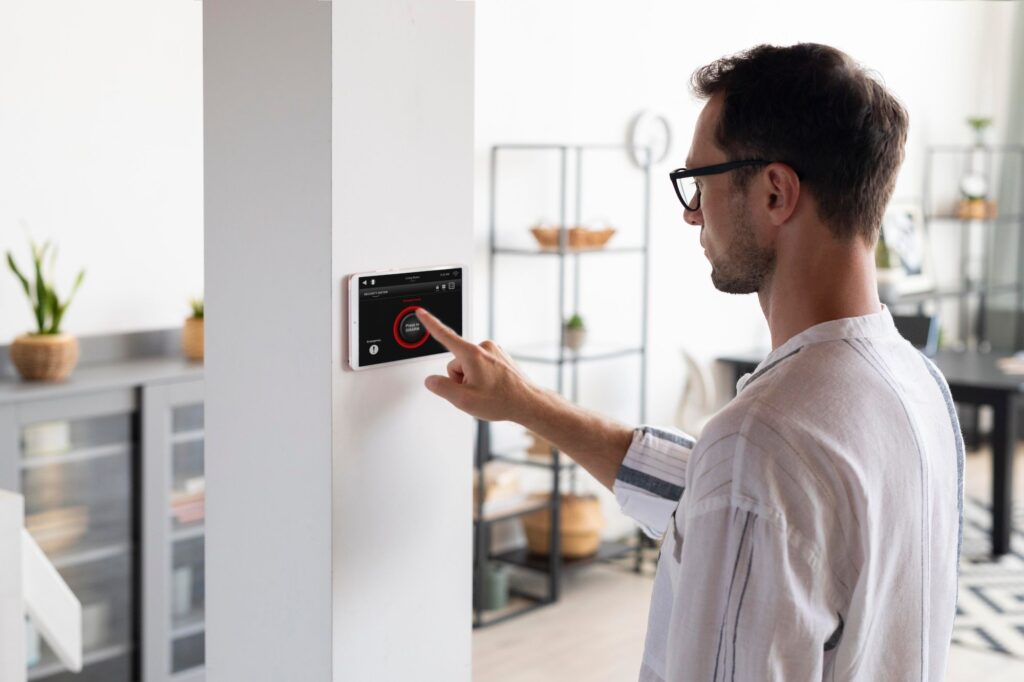Thermostats are an essential element of any central heating system and are generally mounted on a wall, usually in the hall. However, if you’re installing a new thermostat, it’s usually best to position it in the room you want to be the warmest, ie the living room.
Thermostats control the temperature of your central heating system and some also control heating timings. The three most common types are:
- • Temperature regulating thermostat
- • Smart Controlled thermostat
- • Combined programmed time and temperature thermostat
Temperature Regulating Thermostats
Temperature regulating thermostats are basic and very simple to use with either a manual dial or a digital display for setting the desired temperature. They turn the heating on and off to maintain the set temperature. These units are a good choice for people who want a simple and straightforward way to control the temperature in their homes. They are also affordable, making them a popular choice with budget-conscious homeowners. However, they do not offer the advanced features and energy savings of smart-controlled or programmable thermostats.
Pros:
Affordable. Much cheaper than other types of thermostats – a good choice for those on a budget.
Easy to use. These thermostats are straightforward and easy to use, requiring little to no technical knowledge to operate effectively.
Reliable. Because of their simple design, they are often more reliable than more complex thermostats, with fewer potential points of failure.
Cons:
Limited features. Fewer features and functions compared to other types of thermostats, thereby limiting the level of control and customisation available to the user.
Less energy efficient. Without the ability to set schedules or make real-time adjustments, temperature regulating thermostats can lead to inefficient energy use and higher energy bills.
No remote control. Temperature regulating thermostats typically do not offer the ability to control the heating from a remote location, reducing convenience for the user.
No ‘learning function’. So won’t learn your heating preferences and make automatic adjustments.
Combined Programmed Time and Temperature Units
Combined programmed time and temperature units (also known as programmable thermostats) are a cost-effective and efficient solution for managing your home’s central heating system. These thermostats allow you to set specific temperatures for different times of the day and different days of the week, ensuring that your home is always at the right temperature, even when you’re away.
Programmable thermostats are also designed to be user-friendly and easy to use. They come with intuitive interfaces and clear, easy-to-read displays.
Pros:
Increased Energy Efficiency. These units allow for the setting of heating schedules in advance, reducing the need for manual adjustments and potentially reducing energy waste.
More convenient. The ability to pre-set schedules means that the heating will come on automatically at the desired times, reducing the need for manual adjustments and making it more convenient for the user.
Enhanced Comfort. By automatically adjusting the temperature at set times, combined programmed time and temperature units can ensure that the heating is on when it is needed, providing warmth at exactly the right time.
Cost-Effective. These units can be more cost-effective than separate time and temperature control units, as they combine the functions of both into one device.
Cons:
Complexity. Some combined programmed time and temperature units can be complex to set up and use, requiring the user to have a certain level of technical knowledge.
Limited Flexibility. The pre-set schedules may not be suitable for all users, and the lack of real-time adjustments can limit flexibility.
Dependence on Technology. These units rely on technology, which can be subject to malfunctions, power failures, or other issues, potentially impacting heating control and comfort.
Limited Customisation. Pre-set schedules and limited real-time adjustments can limit the level of customisation available to the user, potentially reducing overall control and comfort.
Smart-controlled thermostats
Smart-controlled thermostats are connected to the internet and can be controlled from your smartphone app or web browser. They can learn from your temperature preferences and automatically adjust to energy-saving temperatures when you’re away. Not only will this save you money on energy bills, but it will also reduce your carbon footprint.
Smart-controlled thermostats also provide usage reports and alerts. which is a great way to gain valuable insights into your home’s energy consumption.
They will also integrate with other smart home devices, such as Alexa or Google Nest, allowing for automation and voice control.
Investing in a smart-controlled thermostat is a great choice for anyone looking to save money on energy bills, reduce their carbon footprint, and enjoy the advanced features of a smart home.
Pros:
Increased energy efficiency. Smart thermostats can automatically adjust the temperature in response to your schedule, usage patterns, and energy-saving goals, thereby reducing energy waste and lowering energy bills.
Remote control. Smart thermostats can be controlled from anywhere, via a smartphone app.
Enhanced comfort. Smart thermostats can learn your heating and cooling preferences, automatically adjusting the temperature to suit your household’s needs.
More convenient. With a smart thermostat, you can set schedules, adjust temperature settings, and receive alerts remotely, without ever having to leave the couch.
Cons:
Upfront cost. Smart thermostats are often more expensive than traditional thermostats.
Dependence on technology. Smart thermostats rely on technology, which can be subject to malfunctions, internet outages, or power failures.
Privacy concerns. Some consumers are concerned about the data that smart thermostats collect and how it is used by the manufacturer and third parties.
Complexity. Some smart thermostats have a steep learning curve and can be challenging for some consumers to set up and use effectively.
In conclusion
Regardless of the type of thermostat chosen, each has its own unique features and benefits, making it important for homeowners to consider their individual needs, preferences and budget when making a decision.
Still unsure which thermostat would best suit your needs? Call WaterGuys on 020 313 77749 for a friendly chat. We’ll be happy to go through the options available to you.
